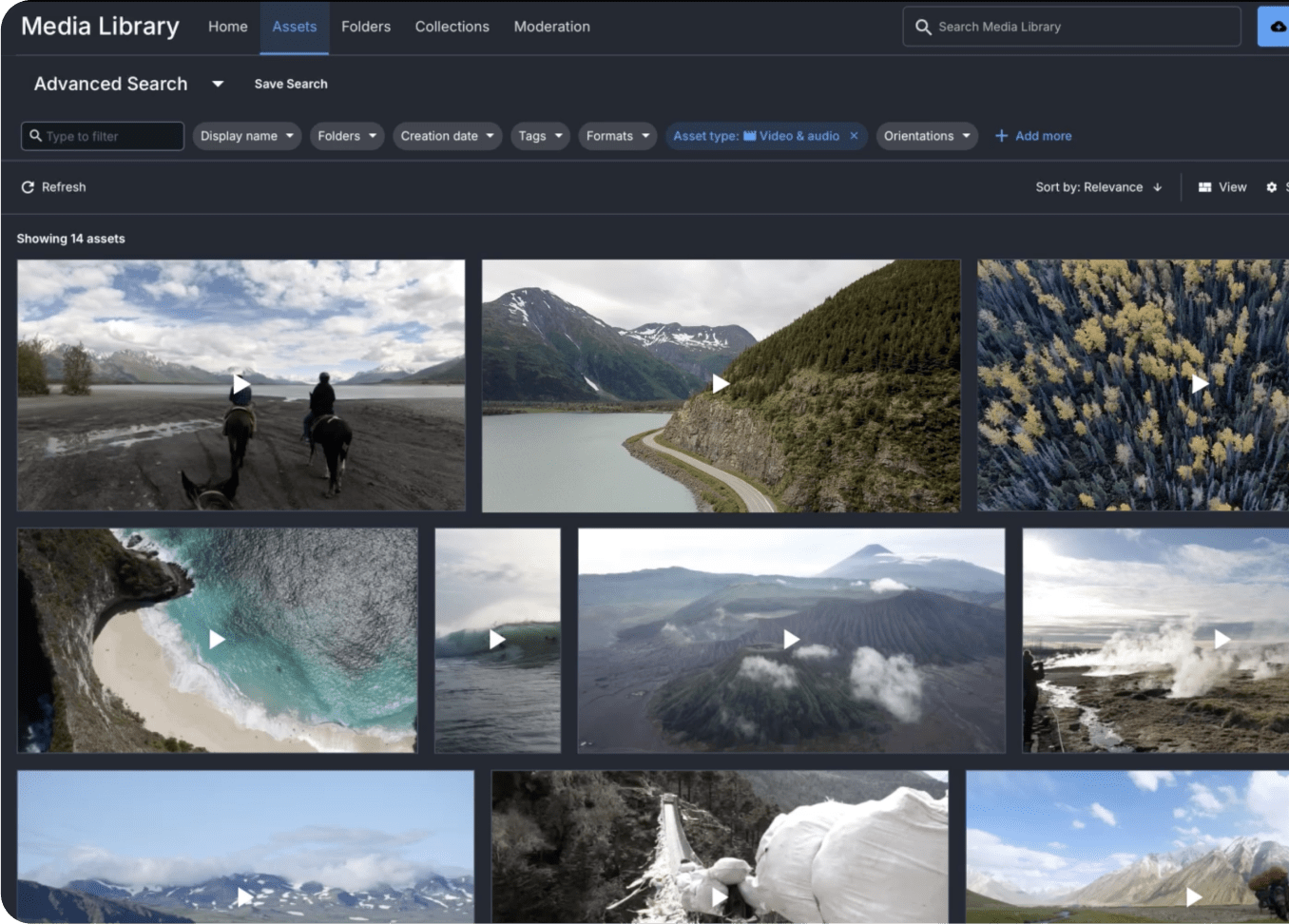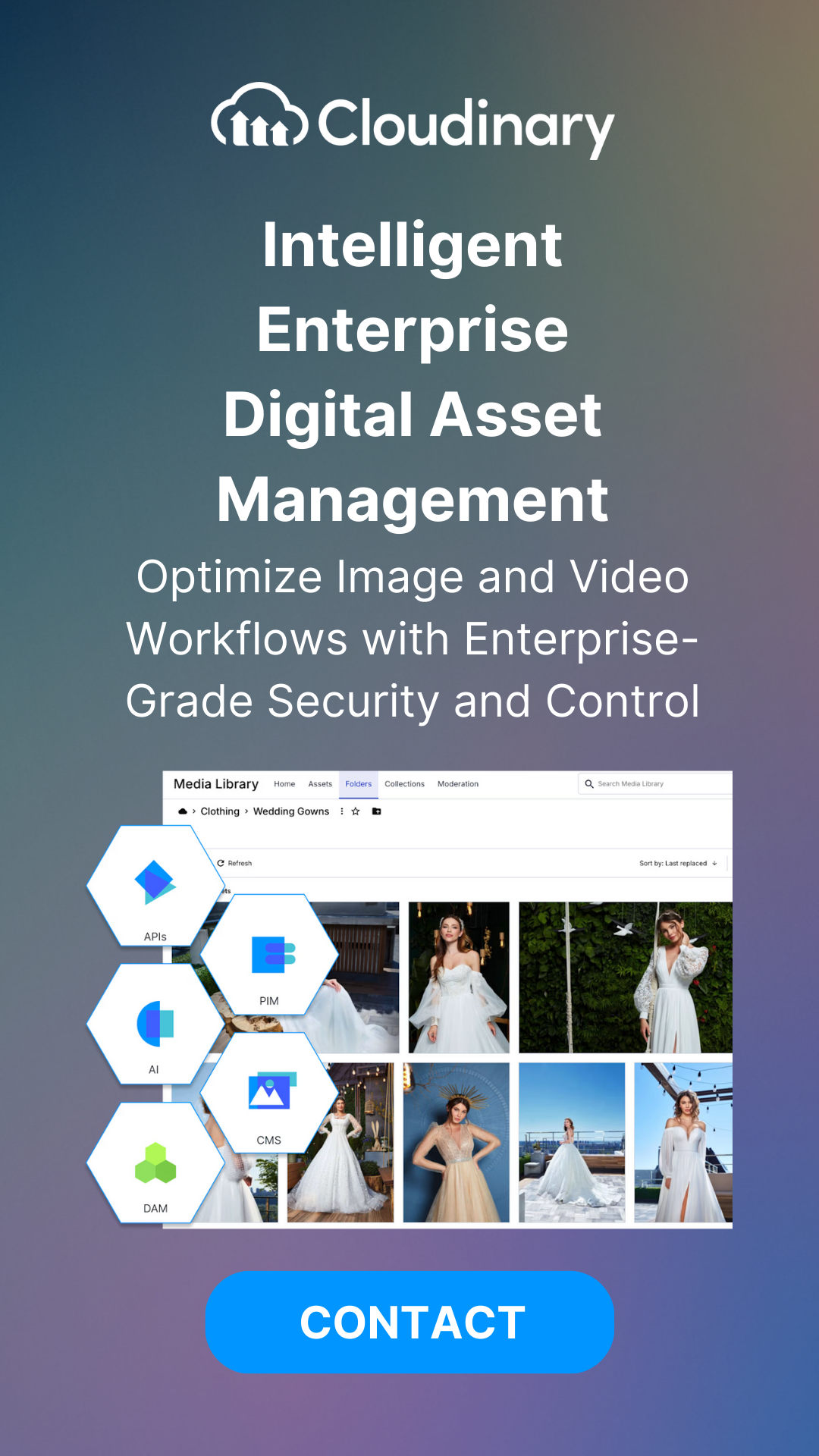
Content is the engine behind nearly every customer experience; and it’s being created at an unprecedented pace. From high-res images to short-form video and immersive 3D, teams are producing more assets, in more formats, for more channels than ever. But as content scales, so does the complexity of managing it.
Enterprise digital asset management (DAM), also known as enterprise media asset management (MAM), is essential for large organizations seeking to efficiently store, organize, share, and manage vast volumes of digital media (such as images, videos, audio, and documents) across their entire lifecycle. These systems provide a centralized platform, acting as a single source of truth to ensure brand consistency and streamline workflows across departments. By implementing enterprise DAM, organizations benefit from improved productivity, enhanced collaboration, better brand governance, and maximized return on digital content investments.
In this article, we’ll explain why enterprise digital asset management systems are essential for businesses. We’ll cover the key features you should look for, like scalability, security, and integration options. Finally, we’ll discuss the future of DAM, especially how AI is making asset management smarter and faster.
In this article:
- What Exactly Is Enterprise Digital Asset Management?
- What To Look For in Enterprise Digital Asset Management Solutions
- How to Choose the Right Enterprise Digital Asset Management Solution
- How Cloudinary Tackles Enterprise Digital Asset Management
- How AI Impacts Digital Asset Management
- Tailoring the Right DAM Solution for You
What Exactly Is Enterprise Digital Asset Management?
As businesses expand, so does the need for efficient DAM. Whether dealing with images, videos, presentations, or design files, enterprise digital asset management systems help you organize, store, and retrieve these assets effortlessly. DAM is a solution to streamline how digital assets are handled at scale. But it’s more than just a storage system; it’s a critical component of your workflow, ensuring that assets are available and easy to find, change, and repurpose across teams and projects.
The management of digital assets is increasingly complex for enterprises. Having a secure, centralized DAM solution is crucial, with different departments, regions, and stakeholders all needing access to assets. Enterprise digital asset management systems are created with the intention of supporting more than just storing assets; they also provide features for distribution, version control, and real-time collaboration needed to ensure seamless business operations.
Key Attributes and Abilities of Enterprise Media Asset Management Systems
- Centralized Control: All digital assets are managed in a single, unified platform, providing a “single source of truth” for the organization.
- Advanced Metadata Management: Assets are tagged with rich metadata, making them easier to search, retrieve, and organize.
- Robust Search: Intelligent search tools allow users to quickly locate content using keywords, filters, and metadata.
- Workflow Automation: Automates repetitive tasks such as approvals, versioning, and distribution, streamlining content creation and delivery.
- Integration Capabilities: connects with other enterprise systems and creative tools (e.g., CMS, project management, Creative Cloud) to enhance productivity.
- Advanced Security & Access Controls: Features like single sign-on (SSO), role-based permissions, and audit trails ensure only authorized users can access or modify assets.
- Analytics & Reporting: Provides insights into asset usage, performance, and ROI to inform content strategy.
- Scalability: Designed to handle massive volumes of assets and support global teams without performance loss.
The Importance of Digital Assets in Modern Business
Digital assets are the backbone of almost every aspect of a modern business. From marketing to sales, product development to customer support, each department relies on assets that communicate the brand, showcase products, and enhance customer experience. In an enterprise setting, these assets can number in the millions and represent years of investment in content creation.
Failing to manage these assets effectively can lead to wasted time, duplicated work, and inconsistency across various communication channels. This is why a reliable enterprise DAM system is indispensable. It not only saves you the hassle of tracking down assets but also ensures consistency in how they are used, maintaining the integrity of your brand and the effectiveness of your campaigns.
Benefits of Enterprise Media Asset Management
- Improved Productivity: Employees can quickly find and use the assets they need, reducing redundant work and speeding up project timelines.
- Enhanced Collaboration: Facilitates seamless sharing and collaboration across teams, departments, and even external partners.
- Brand Consistency: Ensures that all teams use the latest, approved assets, maintaining consistent branding and messaging across all channels.
- Maximized ROI: Optimizes the use of digital resources, helping organizations extract more value from their content investments.
- Streamlined Workflows: Simplifies the entire process of managing digital content, from creation and approval to distribution and archiving.
What To Look For in Enterprise Digital Asset Management Solutions
It’s important to consider various key features when picking a DAM solution for your company. The major goal of enterprise-level DAM systems is to effectively handle the high volume and complexity of assets, with a key focus on security, scalability, and integration. So let’s dive into some features that you should consider when picking a platform.
Scalability
Scalability is critical when dealing with thousands—or even millions—of digital assets. As your organization grows, your DAM system should be able to handle this increase without impacting performance. Cloud-based DAM solutions, like Cloudinary, offer elastic scalability, meaning you won’t need to worry about outgrowing your system. Whether you’re managing a global brand with teams spread across different regions or scaling up during a busy season, a scalable DAM ensures that your digital assets remain accessible without performance dips.

Security
Security is another core feature, especially for enterprises handling sensitive digital assets. From product launch materials to proprietary design files, keeping assets secure and accessible only to authorized personnel is vital. This is where robust permission settings, encryption, and compliance with security standards like SOC 2 and GDPR come into play. With enterprise DAM solutions, you have full control over who can access, change, or distribute each asset, ensuring your data is always protected.
Integration With Your Existing Infrastructure
An effective DAM system doesn’t operate in isolation; it integrates with the other tools you use daily. Your DAM solution should connect with content management systems, project management platforms, marketing tools, and design software. This ensures your team can work in their preferred environments and have access to what they need.
This means that your digital assets are always at your fingertips, no matter what system you’re using. Integration makes workflows smoother and allows for automation, like automatically resizing or optimizing images for different channels, which reduces the manual work involved in managing assets across multiple platforms.
How to Choose the Right Enterprise Digital Asset Management Solution
Selecting the right enterprise DAM system requires careful consideration of your organization’s unique needs and workflows. With so many options on the market, it’s easy to get caught up in feature comparisons and lose sight of what truly matters—finding a solution that fits your business.
- Scalability is one of the most critical factors when evaluating DAM solutions. If your business is rapidly growing or you’re managing a high volume of digital assets, you need a platform that can scale with your demands. Cloud-based DAM can be a powerful option, as they offer flexible storage options that grow alongside your business without compromising performance.
- Accessibility can also be a big factor to consider. While some DAM systems offer extensive customization and advanced features, they can also be complex to set up and maintain. It’s essential to balance the features you need with the resources your team has available.
- Integration capabilities are also crucial when choosing an enterprise DAM. As enterprises rely on various tools— from content management systems to customer relationship management platforms—a DAM that integrates into your existing tech stack will save time and improve efficiency. Cloudinary excels here by providing APIs and SDKs that integrate with numerous platforms, from WordPress to Shopify, ensuring that your digital assets are accessible no matter your tool.
- Security should not be overlooked, especially for enterprises managing sensitive digital assets. Ensure the DAM solution you choose complies with security standards and offers robust user permissions. This guarantees that only authorized individuals can access your assets, reducing the risk of unauthorized use or breaches.
How Cloudinary Tackles Enterprise Digital Asset Management
As a cloud-based platform, Cloudinary is designed to help organizations manage, optimize, and deliver digital assets—whether images, videos, or other media— across various channels.
Cloudinary goes beyond just storing assets. It offers advanced media management capabilities, such as automatic image and video optimization, ensuring that any device or platform delivers your assets in the best possible quality and size. For example, it can automatically compress images or resize videos, speeding up load times without sacrificing visual quality—critical for businesses that rely on fast, consistent digital experiences.
One of Cloudinary’s key strengths is its scalability. As your business grows and your asset library expands, Cloudinary adapts. It provides elastic storage and processing power, so you don’t need to worry about outgrowing the platform, even if you’re managing thousands or millions of assets. This is vital for enterprises that deal with high volumes of content and require a system that can keep up with their evolving needs.

The Cloudinary platform also easily connects with various tools, including CMS, e-commerce platforms, and design software. This flexibility ensures that your teams can access and manage assets without disrupting their workflows, improving efficiency across the board.
How AI Impacts Digital Asset Management
Artificial intelligence is already revolutionizing how enterprises manage digital assets, and its impact will only grow. AI-powered tools in DAM systems can automate tedious tasks like tagging, categorizing, and organizing assets. For instance, rather than manually adding metadata to each asset, AI can analyze content and automatically assign relevant keywords, making assets more accessible to search and retrieve.
One of DAM’s most significant AI advancements is the ability to analyze image and video content. AI can quickly help users locate specific assets within extensive collections through facial recognition, object detection, and context analysis. Imagine needing to find a particular video clip of a product demonstration among hundreds of similar files—AI can identify the relevant content based on visual and audio cues, saving you countless hours of manual work.
In addition, AI-driven analytics are starting to play a more significant role in DAM. By analyzing how assets are used across different channels, AI can provide insights into which types of content perform best, guiding future content creation and optimization. This is particularly useful in enterprises where teams work across multiple regions and must adapt assets for different audiences.
Cloudinary already integrates AI capabilities to streamline image and video management, offering features like automatic cropping, resizing, and format optimization based on the device or platform. This reduces the manual labor in preparing assets for different use cases, letting teams focus more on creativity and strategy.
Tailoring the Right DAM Solution for You
Choosing the right DAM solution for your enterprise isn’t a one-size-fits-all process. Every organization has unique needs based on size, industry, and digital content strategy. Whether you’re looking for a DAM solution to improve your internal workflows or to manage external-facing content across global markets, Cloudinary can help.
With Cloudinary’s highly flexible and scalable DAM platform, you can easily optimize and manage your digital assets. Our platform integrates with your existing tools and workflows, making the transition smooth while unlocking the full potential of your digital content. Whether you’re focused on improving performance, ensuring brand consistency, or scaling your digital operations globally, Cloudinary’s enterprise DAM solution is designed to meet your needs.
Contact us today to explore how Cloudinary can tailor a DAM solution that empowers your teams and accelerates your business. We’re here to help you maximize the value of your digital assets while simplifying asset management so you can focus on what matters most—delivering exceptional experiences to your customers.



